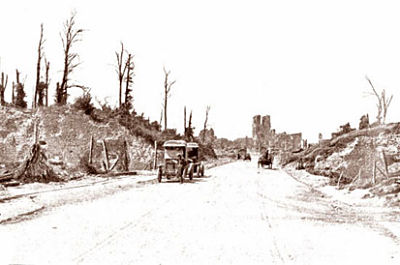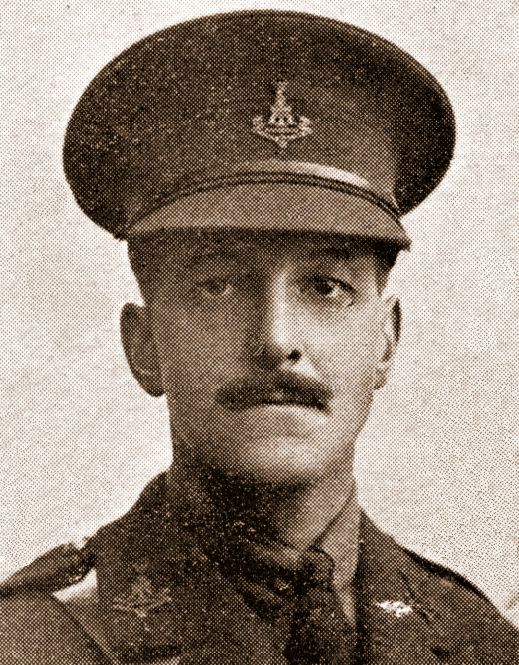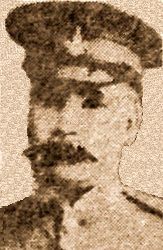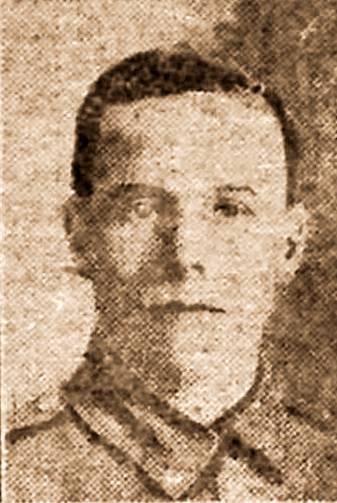 Lt W P Orde-Powlett.
Lt W P Orde-Powlett.
|
14 MAY
3020 Pte Barry Albert. Home at Oakhill in Bath, Durham. Born Bishop Middleham, Co Durham.
Enlisted Northallerton, N Yorks. Died of wounds. Buried at Boulogne Eastern [Hospital] Cemetery.
2315 Pte Scott Norman. Home at Middleton Tyas Yorks. Enlisted at Barton. Killed in action.
Age 21. Menin Gate Memorial Ypres.
17 MAY
2Lt William Percy Orde-Powlett was killed in action. Age 21. He was the eldest son of William George Algar Orde-Powlett MP,
the 5th Baron Bolton and Lady Bolton of Wensley Hall near Leyburn in Yorkshire.
|
 Pte T H Hartas.
Pte T H Hartas.
|
He was born on April 7th 1894 and educated at Eton from 1908 to 1913 followed by Trinity College at Cambridge where he read
Science and Biology.
He joined the 4th battalion as a 2nd Lt in September of 1914 and arrived with the battalion at Boulogne on April 18th 1915.
N Yorks. Commemorated on the Menin Gate Memorial, Ypres and Wensley, Yorks Memorial.
19 MAY
1946 Pte Hartas Thomas Henry. Home at West Tce, Stokesley, N Yorks, place of enlistment.
Born at Ampleforth, N Yorks. Died of wounds aged 28. Prior to the War he had been a Miner at the Rosedale Ironstone mines.
He had been wounded on the 4th May and sheltered in a ruined building for several days before he was found. He was repatriated
to the UK and died in Hospital at Cambridge. He left a widow, Ann Elizabeth and 3 children. He is buried at Stokesley Church Burial Ground.
23 MAY The 50th Division was temporarily split up and attached to various others.
|

The Battle of Bellewaarde 24th/25th May 1915.
|
The York and Durham Brigade was placed with the Cavalry Corps who were defending the line to the West of Bellewarde
Lake.
The 4th Yorks Bn section of this was with the 9th Lancers defending the position astride the Menin Road at Hooge.
The danger from German howitzers [guns that fire big shells in a looping trajectory] was constant.
The march through Ypres at night is described as:-
"an awe inspiring sight. One long street we passed through
going towards Cloth Hall was on fire on both sides of the road."
During the course of the War, Ypres was reduced to rubble and many troops hit while moving to and from the Front.
24 MAY
Whit-Monday. At dawn the Germans opened up with Artillery, machine guns and rifles.
[History of the 50th Division -"Ten months of the War had passed and still trench warfare was in its infancy.
The enemy better prepared for static warfare, was well provided with trench mortars, hand and rifle grenades and rifles
with telescopic sights for sniping.
|

The Site where the Menin Gate Memorial was built after the War, with the ruins of Cloth Hall in the
background.
|
Our trench weapons were woefully inadequate.
The trench mortars we were using
were either hastily improvised weapons or centuries old.
Some were of iron, other of brass; all at first more
dangerous to the firers than to the enemy. Hand grenades were similarly primitive and of the several improvised patterns
the "jam-pot", "Battye Bomb" and "hairbrush" were most generally favoured. Recipe for "jam-pot" bomb.
"Take a jam pot.
Fill it with shredded gun-cotton and ten penny nails, mixed according taste.
Insert a No 8 detonator and short length
of Bickford's fuze.
Clamp up the lid. Light with a match, pipe, cigar or cigarette and throw for all you are worth".
The "Battye Bomb" consisted of a cast-iron cylinder about four inches in length and two inches in diameter, filled with
an explosive, generally ammonal, and closed by a wooden plug through a central hole in which a detonator and fuze were
inserted.
The "hairbrush" was made by making fast a slab of gun cotton to a flat piece of wood of hairbrush shape,
It was ignited in the same way as the "jam-pot".]
|

The 50th Division Memorial.
Situated near Wieltje, a village to the North East of Ypres. See map above.
|
Once more the Germans released their new weapon, chlorine gas that formed great clouds forty feet high and these
drifted with the wind onto the British lines.
It was said the gas was experienced some 20 miles behind the front and, as the Divisional
History says, what the effect was on those immediately opposite the release cannot be imagined.
Many were overcome by the fumes before they could fit their primitive respirators, but when the Germans attacked
they were met with a hail of rifle and machine gun fire that drove them back.
The bombardment continued until 7.30 am, but the line held.
The Battalion Diary recorded:-
Lt H.W. Cummins and 2Lt E.F. Hutchinson were killed. [He had joined the Battalion only two days previously.]
CSM Myers again distinguished himself.
CSM Bainbridge was splendid.
Privates
Perry and Ekins also deserve mention. One man got into the machine-gun emplacement of one of the Hussar
regiments, where he found only the officer, working the gun with him.
He stayed until he [the man] was killed.
During the day Major H G Scott drove round and round in the commandeered ambulance car picking up wounded and
gassed men who were straggling back to dressing stations.
At night the remainder of the garrison of our trenches were relieved and straggled back"
Casualties were 5 officers and 198 other ranks.
Local newspaper:-
Mr R C Heron, tailor, of Wilson Street, Middlesbrough, has received the following interesting account of the trench fighting from his son Pte J P Heron of the 4th Yorks Battalion -
We have just come through the worst fight we have had since being out here. We were only ten yards apart and the Germans were throwing hand grenades at us and were simply blowing us to bits.
I never expected to get out of it alive and thought it was a matter of fighting to the last, but I am please to say I am here.
I am afraid some of our clique have gone under, for they are missing and we have had no report of them yet.
|
It happened that I and a chum got together in the trench and were told to follow an officer [with some other men] to try and cut the Germans off.
We set off wading in a stream of slimy mud up to our waists under the fire of two German maxim guns, which were literally mowing our poor men down and I following the officer for about 300 yards under these conditions.
Then we spotted one of our poor lads lying nearly buried in mud and water with one arm shot off. The officer told us to try and get him to a dressing station.
So we went over to him. The poor lad was in agony. We managed to bandage what was left of his arm and then commenced the hardest task of all, that was to remove him.
We could only carry him about ten yards at once as we could not get hold of him for slime and mud and he was so heavy.
You may know what a struggle we had, as it took us 2 hours to get him to a dressing station, but we had the safisfaction of knowing that we had saved his live, for the doctor said he would have bled to death.
My chum suggested going out to look for more wounded, as we had both lost our belongings and our rifles as well.
So off we went to the firing line again and brought in several chaps who had been gassed until we were utterly exhausted.
Pt W Forsyth, the chum referred to above, has written to his parents at the Extension Hotel, Middlesbrough, about the same incidents.
2099 Pte John Pierson Heron was an early volunteer to serve in the War and was probably in the Territorials before it started.
In civilian life he had been a "Cutter" in his father's tailoring busines. He went out to France when the 4th Yorks first went on the 17th April 1915.
In November 1915 he was selected for Officer Training and finished the War as a Captain in the 3rd Battalion of the Yorkshire Regiment. He was awarded the Military Cross.
His pal, Pte William Forsyth, had Battalion number 2097, just 2 below John's and presumably they had enlisted together.
At some point he was transferred to the Kings Own Scottish Borderers and the Labour Corps. This often occurred after recovery from wounds.
The following 20 men of the Battalion were killed in action on the 24th and are commemorated on the Menin Gate Memorial.
|

Lt Herbert Waller Cummins.
|
Lt Herbert Waller Cummins Killed in action, aged 35. the son of Jane and the late William John Cummins of Clarence, Bishop Auckland and West Burton, Aysgarth, Yorkshire.
He was born on March 18th 1880 at Bishop Auckland in Co Durham and educated at the North Eastern County School at Barnard
Castle. He then worked for Barclays Bank in Bishop Auckland and then at the head office in Darlington.
In his spare time he was a keen golfer and won the 1913 Durham County Championship. He held the amateur record for the Bishop Auckland Club.
He was gazetted 2nd Lt in September 1914 and Lt in
October 1914.
He was killed by a "hand bomb", his death being instantaneous and his body never recovered.
He is commemorated on the Menin Gate and also on plaques in Barnard Castle School and Barclays Bank, Darlington.
The CO wrote:-
“I am sorry to say we have been unable to recover any of the things he had on him. He was a most gallant and brave officer and we all feel his death greatly”
[Photograph kindly contributed by his Great Great Niece, Carrie Lowe.]
|

Plaque in St Peter's Church, Bishop Auckland.
"To the glory of God and in proud and loving memory of"
Herbert Waller Cummins
Lieut. 4th Battn. Yorkshire Regt. T.F.
(Alexandra, Princess of Wales’ Own)
Youngest and dearly loved son of Jane and the late W.J. Cummins
Born March 18th 1880 – Killed in action in
Zouave Wood. At the 2nd Battle of Ypres. May 24th 1915.
whilst gallantly defending his sector of trench
For King, Country and Freedom
I am the Resurrection and the life saith the Lord: He that believeth in me though
he were dead, yet shall he live, and whosever liveth and believeth in me shall never die.
St John, XI, 25.26.
|

Pte James A Andrew.
|

Pte Clarence Bargewell.
|
2163 Pte Andrew James A. Home at 64 Duncan Rd, Middlesbrough, place of birth. Enlisted at Northallerton.
Age 19.

190 Pte Bargewell Clarence. Home at 83 Ernest St, Middlesbrough, N Yorks, town of
birth and enlistment. Age 22. At the 1911 census he was living at home with his 5 brothers and 3 sisters and employed as an apprentice steel moulder at a local foundry.[Photograph kindly contributed by Mick Trainor of New Marske, N Yorks.]
821 Sgt Baxtrem Francis. Aged 28. Born Grangetown, Middlesbrough, town of enlistment.
At the 1911 census he was living with his widowed mother, Prudence [nee Davis] and sister Margaret with other members of his
mother's family at 24 Ayresome Grange Rd, Middlesbrough. He was employed as a bridge building plater.
|
2076 L/Cpl Bunting Ernest R. Home at S Bank N Yorks, place of birth and enlisted at Middlesbrough.
Age 34.
2887 Pte Carter William. Home at Liverton Mines N Yorks.
1568 Pte Earls William. Home at - 47 Mills St, Newport, Middlesbrough N Yorks, place of enlistment.
Born at Thornaby on Tees. Age 24.
|

Sgt Tommy Johnson.
|

Sgt Herbert Cooke.
|

Pte Thomas W Cox.
|

Pte William Ord.
|

Pte John E Ryder.
|
478 Sgt Johnson Thomas. Home at 17 Milbank St, Skelton in Cleveland, N Yorks. Born at Stockton on
Tees and enlisted at Middlesbrough, N Yorks.
288 Sgt Cooke Herbert. Born and enlisted at Middlesbrough, N Yorks.
|

Sgt Herbert Cooke's War Medals.
[Photograph kindly donated by his Great Nephew, Steve Cooke.]
|
2187 Pte Cox Thomas William. Home in Middlesbrough, town of birth. Enlisted at Northallerton.
Local paper notice -
COX - Killed in action, in first line trenches in Belgium, on May 24th.
Private T. W. Cox [Tommy], age 24, 4th Yorks, dearly beloved son of J and H Cox, 7 Albyn Terrace, Middlesbro.
2470 Pte Ord William. Home at Ryehill Farm, Nunthorpe. N Yorks. Born in 1891 at Nunthorpe and enlisted at
Northallerton, N Yorks. Went to France 18 April 1915.
He was the son of John Ord, born Skelton in 1864, a Farm Stockman and Jane Charlton of Hutton Rudby.
He grew up with 6 sisters and a brother at Ryehills Farm.
His brother, John, was killed in the War just 18 days before the Armistice.
At the 1911 census William was working as a "motor Driver, domestic", very likely for Arthur Dorman, the iron and steel magnate of Grey Towers, Nunthorpe.
[additional information kindly provided by the Great Ayton History Society.]
2529 Pte Ryder John Erskine. Home at 143 Linthorpe Rd, Middlesbrough, N Yorks, place of
enlistment. Age 19.
1488 Pte Lane Herbert. Home at 28 Ash St, Middlesbrough, N Yorks, place of birth and enlistment.
Age 20.
1235 Pte Murray Arthur. Home at 75 Commercial St, Middlesbrough, N Yorks, place of birth and
enlistment. Age 22. W" Company.
3172 Pte O'Grady Thomas. Home at 81 Parliament St, Stockton on Tees, place of birth. Enlisted at
Northallerton, N Yorks. Age 22.
|

Cpl R G Wallinger.
|
996 Cpl Wallinger Richard George. Born at Seaton Carew and enlisted at Yarm. Age 34.
Corporal Wallinger was the son of Ellen Hansom (formerly Wallinger) of Urlay Nook and the late William Wallinger.
Husband of Jane Ann Calvert formerly Wallinger) of No1 Newlands Road Egglescliffe, Co Durham. Richard Wallinger married Jane Ann Hutchinson
at St. Mary's Church Egglescliffe on the 9th December 1905. A son Richard George was born on the 17th July 1914.
Richard George Wallinger was one of four brothers, George William, Norman, and Septimus Claud all serving in different regiments in the in the 1914-1918 War.
1040 Pte Ryder Robert. Home at 10 Rose St, Middlesbrough, N Yorks, place of birth and enlistment.
Age 25.
1502 Pte Stant George Ernest. Home at Aran, Catterick, N Yorks, place of enlistment, Born at
Liverpool. Age 19.
|

Lt E F Hutchinson.
|
2414 Pte Stewart Jack. Home at 47 Corporation Rd, Darlington, Enlisted at Northallerton.
Age 22. W" Company.
1313 Pte Webb George William. Home at 8 Pearson St, Middlesbrough, N Yorks, place of birth
and enlistment. Age 21. A" Company.
2Lt Edgar Francis Hutchinson Age 24. Born on 3rd March 1891. Died of wounds. Son of James M. and Elizabeth Hutchinson, of
Gilside House,2, Victoria Rd., Saltburn-by-the-Sea, Yorks.
He was educated at Darlington Grammar School and qualified as a solicitor in January of 1914 working for the Middlesbrough
firm of M W & E F Hutchinson.
He volunteered as a Private in November 1914 and joined the Inns of Court Officer Training Corps
in December of 1914
London Gazette. 12 March 1915. "To be Second Lieutenants. Private Edgar Francis Hutchinson, from the Inns of Court
Officers Training Corps."
He joined with the 4th battalion on May 21st 1915 when they were on the railway embankment just outside
Ypres.
|

Pte E Vaughan.
|
On May 23rd the battalion moved up to front line trenches astride the Menin Road at Hooge.
The following day, Whit Monday,
the Germans launched a gas attack followed by an infantry assault. 2nd Lt Edgar Francis Hutchinson was killed by rifle fire, shot in the chest, in this action on May 24th 1915 just two days after joining the Battalion.
He was buried in the L’ecole de Bienfaisance near the asylum in Ypres, but when graves were concentrated after the war his body was
moved and he now lies in Bedford House Cemetery, South of Ypres on the road to St Eloi.
[His photograph kindly contributed by Kevin Galloway of Thornaby on Tees.]
1230 Pte Vaughan Edward. Home at South Bank, Middlesbrough, N Yorks. Born at Maryport, Cumberland
and enlisted at Eston, N Yorks. Buried at Bedford House Cemetery.
|

Pte Charles W Adamson.
|

Pte Reubin English.
|

Pte Samuel H Jones.
|

Pte Lauri Ovington.
|

Pte James Pryke.
|

Pte Charles H Tuck.
|

Pte James Walls.
|
These six lads were among the many who were wounded. They all went to France with the Battalion on the 18th April 1915.
The exact date and details of their injuries is not presently known and probably never will be.
We know about this only because their families sent in their photographs to local newspapers in the weeks following.
2560 Charles William Adamson, from Middlesbrough. He served the rest of the War and was disembodied on the 14th Feb 1919.
1371 Reubin English. from Eston, N York. He was discharged on the 13th November 1916
1922 Sam Jones, from Middlesbrough. He served the rest of the War and was disembodied on the the 26th March 1919.
858 Lawrence "Lauri" Ovington. from Middlesbrough. He was discharged on the 31st March 1916.
2292 James Pryke, from Middlesbrough. He served the rest of the War and was disembodied on the 4th April 1919.
452 Charles Henry Tuck, from South Bank, Middlesbrough. He was discharged on the 20th May 1916.
A list, as yet incomplete, of all the lads who went to France in 1915 and qualifed for the Volunteers 1914/15 Star can be seen by clicking -
here
Martin Jones, of Ferrensby, near Boroughbridge, N Yorks, whose Great Grandfather, 314 Pte James Walls, was gassed at Hooge on the 24th May 1915 has contributed a map of the above operations and the following pages from the
War Diary of the 9th Lancers, to which Unit the 4th Yorks were attached during this period.
Pte Walls had enlisted in our local Territorials in 1901 and went to France when the 4th Yorks first went on the 18th April 1915. He was awarded the Long Service Medal.
He was re-patriated to the UK after suffering the effects of chlorine gas and was discharged from the Army in April 1916, as no longer fit for the demands of the Infantry.
But Martin has found a record of his daughters Baptism in Stockton in 1917 and his occupation was soldier.
He had re-enlisted back into the Army into the Cheshire Regiment, although it was transferred to the Labour Corps.
He went back to France and served the rest of the War there. He died in 1941 due to chronic bronchitis, the gassing was probably the underlying cause.
|
|



